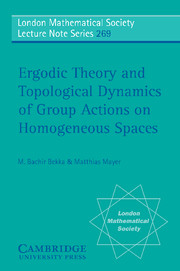Book contents
- Frontmatter
- Contents
- Preface
- Acknowledgment
- I Ergodic Systems
- II The Geodesic Flow of Riemannian Locally Symmetric Spaces
- III The Vanishing Theorem of Howe and Moore
- IV The Horocycle Flow
- V Siegel Sets, Mahler's Criterion and Margulis' Lemma
- VI An Application to Number Theory: Oppenheim's Conjecture
- Bibliography
- Index
Preface
Published online by Cambridge University Press: 05 August 2013
- Frontmatter
- Contents
- Preface
- Acknowledgment
- I Ergodic Systems
- II The Geodesic Flow of Riemannian Locally Symmetric Spaces
- III The Vanishing Theorem of Howe and Moore
- IV The Horocycle Flow
- V Siegel Sets, Mahler's Criterion and Margulis' Lemma
- VI An Application to Number Theory: Oppenheim's Conjecture
- Bibliography
- Index
Summary
These notes axe based on lectures given in 1994 by the first author at a Summer School in Tuczno (Poland) and at the University of Metz.
The purpose is to give a quick introduction to ergodic theory, to study interesting examples as illustration and to present some recent and spectacular developments in topological dynamics of group actions. More precisely, the focus will be on the following two types of systems of a geometrical–algebraic nature:
The geodesic flow on the unit tangent bundle of a locally symmetric space and unipotent actions on homogeneous spaces. Classical examples are the geodesic flow and the horocyclic flow on the unit tangent bundle of a compact Riemann surface of constant negative curvature. These flows are among the most studied dynamical systems. Of particular interest are their ergodic (or mixing) properties and the asymptotic behaviour of their orbits.
Unipotent actions on homogeneous spaces enjoy remarkable regularity properties. A striking illustration of this regularity is Hedlund's minimality theorem: for any lattice Γ in G = SL(2,ℝ), any orbit in the homogeneous space Γ\ G under a unipotent subgroup of SL(2,ℝ) is either periodic or dense. Such actions have close connections to problems in Number Theory. For instance, one of the most spectacular application of unipotent actions is the solution in 1987 by Margulis of Oppenheim's conjecture which was open for more than 40 years (see [Ma3]).
- Type
- Chapter
- Information
- Publisher: Cambridge University PressPrint publication year: 2000

